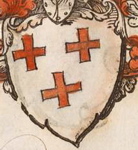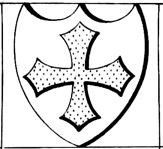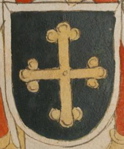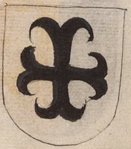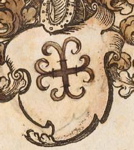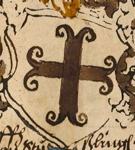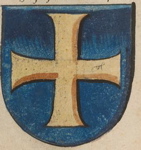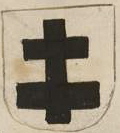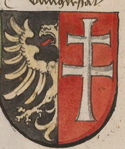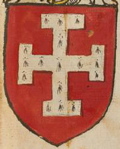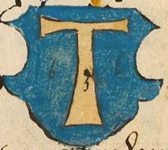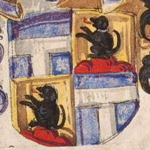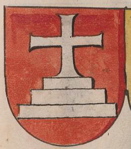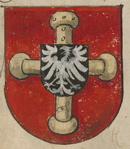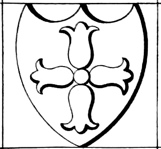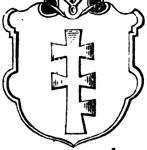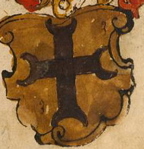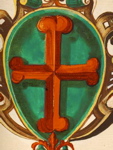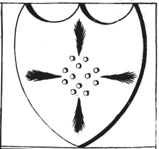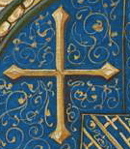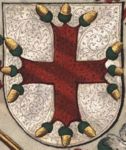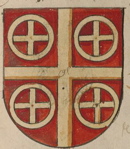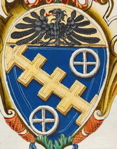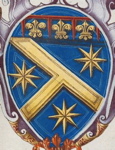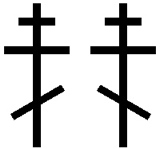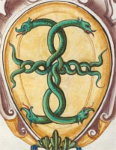plain crosses couped, including Latinate and humetty
There has been one registration in which the term "Greek cross" was used to blazon an equal-armed cross couped.
Argent, three crosses couped gules.
BSB Cod.icon. 390, folio 851
Argent, a Latin cross couped sable.
BSB Cod.icon. 267, folio 93r
on charges within the family only:
"At this time we will formally adopt the definition that any ordinary humetty is couped parallel to the edge of the field. It is an artistic variation of couped; no difference will be granted between the two." (March, 2011 LoAR)
The use of an inverted Latin cross is, in and of itself, not offensive (October, 1998 LoAR).
Special rules apply to the use of crosses couped gules.
On a tower or castle, "Cross that appear to be arrow slits, such as plain crosses. . .will be treated as architectural details - not as tertiary charges," (January, 2008 LoAR), and "artistic details are allowed to have poor contrast," (November, 2009 LoAR).
A cross couped is significantly different from an ordinary cross (January, 2003 LoAR).
related to charges outside the family:
A cross couped is significantly different from a cross of four lozenges (April, 1996 LoAR).
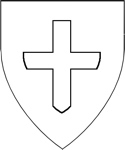
cross humetty
crosses flory, floretty, patonce, clechy, Calatrava, and Santiago
"a Cross of Cleves is a Latin Cross fleury" (September 1973)
Gules, a cross flory argent and in canton an escallop Or.
BSB Cod.icon. 291, folio 24v
Gules, a cross floretty argent.
BSB Cod.icon. 290, folio 28r
on charges within the family only:
"Crosses flory may be both voided and fimbriated. . .." (December, 2009 LoAR)
A cross clechy may be voided. (December, 2007 LoAR)
"The cross of Santiago is one of the more variable forms of period crosses. . .. The bottom arm of the cross is always fitchy. . ..The side arms are an often-flamboyant sort of flory. The top arm ranges from a standard flory, to a subdued form of flory, to a round- or card-pique-shaped 'sword hilt' shape." (July, 2003 LoAR) ". . .[A]n examination of crosses of Santiago from period or shortly after show that the bottom arm of the cross does not necessarily have a flare in the lower limb.. . .We are therefore adjusting our definition of a cross of Santiago to include crosses without a sword-shaped flare to the lower limb." (December, 2013 LoAR)
The difference between a Cross of Santiago and a cross flory fitchy is a flare in the lower limb of the latter (November, 2008 LoAR). ". . .[T]here is not sufficient difference between a cross of Santiago and a cross fleury fitchy. We have traditionally not granted difference for the fitching of a cross." (December, 2013 LoAR)
". . .[A] cross of Calatrava does not have the arms intersecting anywhere except at the center: the arms come straight out, split, each piece heads back towards the center, but the arms do not touch anywhere after the split." (April, 2011 LoAR)
"Barring such a depiction in period, the petals [of a cross fleuretty] should not be joined to the cross." (April, 2015 LoAR)
A cross clechy with the bottom half of the lower limb extended into a long point is not a cross clechy fitchy at the foot. It is an undocumented form not registerable without documentation (September, 2007 LoAR).
A cross clechy is significantly different from a Cross of Santiago (November, 2005 LoAR) and is a Distinct Change from a cross fleury (October, 2015 LoAR).
A cross fleury is not significantly different from a cross patonce (May, 1994 LoAR), a Cross of Santiago (December, 1997 LoAR), or a Cross of Calatrava (January, 2005 LoAR).
A Latin cross flory [or a Cross of Cleves--see the quote in the far left column] is not significantly different from a Cross of Santiago (September, 1996 LoAR).
A properly drawn cross patonce is splayed along its arms, not just at the ends. (January, 2012 LoAR) A cross patonce is not significantly different from a Cross of Santiago (March, 2001 LoAR) or a cross clechy (July, 2004 LoAR).
related to charges outside the family:
"A key cross is a period charge found in the arms of Pisa. It is defined as a cross clechy pommety at the points." (January, 2006 LoAR)
"The cross of Cerdaña is a minor artistic variant of a cross clechy" (July, 2002 LoAR)
"The cross formy floretty may be found in period armory. ." (December, 2003 LoAR)
"A properly drawn cross formy fitched at the foot would have the arms clearly separated." (July, 2014 LoAR)
A cross patonce is substantially different from a Bowen cross (September, 2004 LoAR), significantly different from a cross avellane (September, 2009 LoAR), and a significant change from a cross annulety (January, 2016 LoAR),
A cross clechy is substantially different from a Cross of Saint Brigid (September, 2006 LoAR)
A cross of Santiago is substantially different from two links of chain fretted in cross and from an ankh (November, 2005 LoAR).
A cross fleury is significantly different from a cross of four ermine spots (December, 2002 LoAR), four fleurs-de-lys in cross (August, 1993 LoAR), four fleurs-de-lys bases to center (June, 2007 LoAR), and a Celtic cross (January, 2000 LoAR) and a significant change from a cross annulety (January, 2016 LoAR), but not significantly differet from a Cross of Calatrava (January, 2005 LoAR).
A cross crosslet fleury is significantly different from a crux stellata (July, 1996 LoAR).
A cross swallowtailed is significantly different from a cross patonce and a cross fleury (March, 1993 LoAR).
A Cross of Calatrava is substantially different from a cross of four ermine spots (March, 2011 LoAR), but not significantly different from a cross of four anchors (September, 1990 LoAR) or a cross fleury (January, 2005 LoAR).
Note: A cross clechy has a lot in common with a cross lozenged.
cross patonce
Joseph Foster's 1902 Some Feudal Coats of Arms, page 125
cross clechy
Volume III of William Berry's 1828 Encyclopædia Heraldica, Plate XXXV
a cross of Santiago issuant from a mount between two escallops
BSB Cod.icon. 308, folio 41r
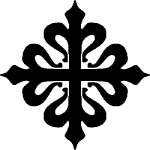
Cross of Calatrava
derived from an image by WarX available under a GNU Free Documentation License
crosses crosslet and bottony
There was one registration, in 1973, of a cross bottony blazoned as a cross "trefly".
A cross crosslet saltirewise (i.e., rotated 45 degrees, so that the members form an "x" instead of a "t") is at least sometimes blazoned as a "Cross of Saint Julian".
Or, a cross crosslet sable.
BSB Cod.icon. 392 d, folio 141v
Sable, a cross bottony Or.
BSB Cod.icon. 308 u, folio 209r
on charges within the family only:
"It is important to recall that the cross bottony and the cross crosslet are both used to represent the same charge throughout our period's heraldry. The bottony form is found predominantly in earlier artwork, and the crosslet form predominantly in later artwork." (August, 2002 LoAR) Consequentially, a cross crosslet is not significantly different from a cross bottony (December, 1999 LoAR).
"Black Stag has shown that, in period, a cross crosslet/bottony fitchy had a bottom limb significantly longer than the other three. Thus these do not need to be blazoned Latin." (August, 2007 LoAR)
A cross crossletted only on the upper three arms has no difference from a standard cross crosslet. (January, 2013 LoAR)
"The default crusilly is of crosses crosslet." (August, 2002 LoAR)
Neither a cross crosslet (June, 2004 LoAR) nor a cross bottony (December, 1993 LoAR) can be voided or fimbriated.
related to charges outside the family:
A cross crosslet is substantially different from a cross of four anchors (September, 1990 LoAR) and from a Bowen cross (October, 2006 LoAR).
A cross crosslet is significantly different from a Celtic cross (December, 1998 LoAR).
A cross crosslet fleury is significantly different from a crux stellata (July, 1996 LoAR).
A patriarchal cross bottony throughout is significantly different from a cross bottony and a cross crosslet (February, 1994 LoAR).
A cross bottony or crosslet is not significantly different from a cross of four swords conjoined at the points (July, 2004). Introducing a little space between the points of four swords in cross, pommels outward, might not be enough to create a significant difference, either, if the overall impression is of a single cross (July, 2005 LoAR).
A cross bottony is not significantly different from a cross doubly pommeled. (April, 2010 LoAR)
A cross avellane is distinctly changed from a cross bottony. (June, 2015 LoAR)
"No documentation was provided that [a cross patee bottony], which looks like a cross bottony with added flanges, was a reasonable variant of period crosses." (July, 1999 LoAR)
"A [doubled cross crosslet] appears on page 416 of Raneke, Svenska Medeltidsvapen. Another appears in 1548 issuant from a trimount as the arms of Hungary on plate 92 of Vigil Rabers Neustifter Wappenbuch, by Harwick W. Arch. It is therefore registerable and not a step from period practice." (April, 2010 LoAR)
"There is substantial difference between a cross glandular and a cross of Saint Julian." (July, 2012 LoAR)
crosses moline, sarcelly, recercelly, anchory, fourchy, fourchetty, and miller
A miller cross is sometimes blazoned as a "cross mill-rind".
Note: "Anchory" is a term sometimes used to describe a cross moline with very curly ends. "Sarcelly" and "recercelly" are alternate terms (the latter, at least, no longer used in the S.C.A.) for a cross moline disjointed.
The cross fourchetty was not mentioned in the original letter defining cross families, but was added in the March, 2012 LoAR.
Argent, a cross moline sable.
BSB Cod. icon. 390, folio 582
Argent, a cross moline sable.
BSB Cod. icon. 307, folio 65
on charges within the family only:
"Recercely" is an ambiguous term and should not be used in S.C.A. blazon (September, 1995 LoAR).
"A cross moline is too complex to fimbriate." (July, 1999 LoAR)
"Crosses moline disjointed have unmistakably forked and curled ends." "It should be noted that when charges are put on a cross moline disjointed, they obscure the identifiability of the cross somewhat;. . .Special care should be taken with the artwork to preserve identifiability of all elements of the armory." (April, 2002 LoAR)
". . .the ends of a cross moline are pointed and deeply curved. . ."; a similar cross with the ends couped flat and only slightly curved should be blazoned "a cross fourchy" (January, 2004 LoAR)
A cross moline is not significantly different from a cross miller (April, 1986 LoAR).
The cross fourchetty is significantly different from a cross moline. (March, 2012 LoAR)
related to charges outside the family:
A cross moline disjointed is substantially different from a cross crescenty (October, 2005 LoAR) and from two links of chain fretted in cross (August 2011 LoAR).
A cross moline is substantially different from an ankh (June, 1996 LoAR).
A cross moline is significantly different from a cross pointed (August, 1990 LoAR), a cross patonce (November, 1992 LoAR), a cross couped of three crossbars missing the dexter base arm (May, 2001 LoAR), and a cross swallowtailed (May, 2010 LoAR).
A cross moline is not significantly different from a cross doubly pommeled elongated palewise (February, 1997 LoAR).
There is registered one piece of armory containing"two millrinds in cross" in which the arrangement is virtually indistinguishable from a cross moline nowy quadrate square-pierced.
Argent, a cross moline sable.
BSB Cod. icon. 390, folio 747
Argent, a cross moline sable.
BSB Cod. icon 392 d, folio 149
Azure, an orle of crosses bottony, overall a cross moline disjointed gules.
from a photo of 16th-century stained glass on Plate 20 of F. Sydney Eden's 1927 The Collection of Heraldic Stained Glass at Ronaele Manor
Argent, a cross fourchetty sable.
BSB Cod. icon. 390, folio 500
cross fourchy
Volume III of William Berry's 1828 Encyclopædia Heraldica, Plate XXXIII

miller cross
Volume III of William Berry's 1828 Encyclopædia Heraldica, Plate XXXIII
crosses formy / paty
Note: "Paty" is used here in the usual S.C.A. sense, as an alternative (now disallowed but used in some older blazons) to the term "formy". It does not refer to anything in the moline or the flory family.
Azure, a cross formy Or.
BSB Cod.icon. 391, folio 191v
on charges within the family only:
Because it is an ambiguous term, the use of "paty" in S.C.A. armory has been abandoned (cover letter to the August, 1986 LoAR, as quoted in the Precedents of the S.C.A. College of Arms for the tenure of Baldwin of Erebor).
". . .[A] cross formy should have the arms splaying outwards from the center, not just at the very end." (July, 2012 LoAR)
A cross formy nowy quadrate is simple enough to fimbriate (July, 2004 LoAR), but a cross formy fitched at the foot is not (November, 2009 LoAR).
A cross formy throughout is significantly different from a cross formy (May, 1997 LoAR) and from an ordinary cross (November, 2003 LoAR).
"There is no difference between a cross formy and a Latin cross formy." (October, 2002 LoAR)
related to charges outside the family:
"No documentation was provided that [a cross patee bottony], which looks like a cross bottony with added flanges, was a reasonable variant of period crosses." (July, 1999 LoAR)
"The cross formy floretty may be found in period armory. . ." (December, 2003 LoAR)
A cross formy is significantly different from a Canterbury cross (October, 1994 LoAR), a cross barby (September, 2002 LoAR), a cross swallowtailed (July, 1999 LoAR), a Bowen cross (May, 1995 LoAR), and a cross bretessed (January, 2003 LoAR).
A cross formy throughout is significantly different from an ordinary cross (November, 2003 LoAR).
A Latin cross formy is significantly different from a Celtic cross (December, 2001 LoAR).
A cross formy quadrate is substantially different from a cross barby (September, 2007 LoAR).
There's no significant difference between a cross patty fitchy and a cross patty convex fitchy. (July, 1985 LoAR)
crosses doubled, patriarchal, and Lorraine
In December of 1991 a "Lithuanian cross" was registered. In the May, 2009 LoAR, it was described as "a cross couped that has two horizontal crossbars of equal length each equally distant from the ends of the vertical bar," and reblazoned "a double cross".
Sable, a doubled cross argent.
BSB Cod.icon. 265, folio 65v
Argent, a cross Lorraine sable.
BSB Cod.icon. 265, folio 62v
on charges within the family only:
"Crosses patriarchal may not be fimbriated. . .." (July, 2010 LoAR)
related to charges outside the family:
A patriarchal cross is substantially different from an ordinary cross (February, 2000 LoAR).
A tau cross double-crossed potent at the foot is significantly different from a double cross (February, 1991 LoAR).
A cross Lorraine is significantly different from a Russian Orthodox cross (December, 2004 LoAR).
A patriarchal cross bottony throughout is significantly different from a cross bottony and a cross crosslet (February, 1994 LoAR).
"A [doubled cross crosslet] appears on page 416 of Raneke, Svenska Medeltidsvapen. Another appears in 1548 issuant from a trimount as the arms of Hungary on plate 92 of Vigil Rabers Neustifter Wappenbuch, by Harwick W. Arch. It is therefore registerable and not a step from period practice." (April, 2010 LoAR)
Per pale sable, an eagle dimidiated of the line of division Or, and gules, a patriarchal cross formy argent.
BSB Cod.icon. 391, folio 167r
the crosses potent / billety and capital
Note: "Billety" is, in this case, nothing more than an alternative way of saying "potent".
Gules, a cross potent ermine.
BSB Cod.icon. 291, folio 23r
Azure, a cross capital between four capital letters A argent.
BSB Cod. icon 391, folio 15v
on charges within the family only:
The cross capital is "a cross formed by conjoining four architectural columns, including their capitals." (November, 2020 LoAR).
A cross potent is too complex to fimbriate (December, 1995 LoAR).
related to charges outside the family:
"In the SCA, a Cross of Jerusalem is a cross potent between four crosses couped." (May, 1982 LoAR)
A cross potent is significantly different from a cross of four anchors (September, 1990 LoAR).
A cross potent quadrate is significantly different from a Canterbury cross (October, 1994 LoAR).
the tau cross
There have been a few registrations in which a tau cross was blazoned a "Cross of St. Anthony" or a "Cross of St. Antony"
Azure, a tau cross Or.
BSB Cod.icon. 392 d, folio 141r
Quarterly azure, a straight tau cross throughout, and Or, a dog sejant erect sable perched on a mount gules.
BSB Cod.icon. 307, page 142
on charges within the family only:
"A straight tau cross looks like a capital T. A normal tau cross has formy arms." (March, 1982 LoAR)
If a tau cross were throughout, ". . .the limbs would reach the edges of the shield, but the crossbar would not become the 'chief.'" (May, 1986 LoAR)
A tau cross swallowtailed is unusual, but "has been formed on the model of the Maltese cross" and is therefore acceptable for use in Society armory (May, 1989 LoAR).
related to charges outside the family:
A tau cross is substantialy different from an ordinary cross (November, 2002 LoAR).
A cross avellane is "at least [distinctly changed]" from a tau cross. (June, 2015 LoAR)
A tau cross double-crossed potent at the foot is significantly different from a double cross (February, 1991 LoAR).
the Cross of Calvary
There is one registration from 1979 in which a cross mounted on steps is blazoned "grady" instead of "of Calvary".
Gules, an equal-armed Cross of Calvary argent.
BSB Cod.icon. 391, folio 171r
on charges within the family only:
". . .a cross of Calvary would have the cross larger than the steps. . ." (December, 2006 LoAR)
related to charges outside the family:
A Cross of Calvary is significantly different from a Celtic cross. (October, 2008 LoAR)
Per pale Or and gules, a Cross of Toulouse counterchanged.
BSB Cod.icon. 270, folio 91r
on charges within the family only:
"A cross of Toulouse, which is a period charge, is effectively a cross clechy pometty on the points and is voided by definition." (December, 2007 LoAR)
"[T]he 'voiding' of the cross of Toulouse is a part of its definition and is not the addition of a tertiary charge." (August, 1995 LoAR)
A cross of Toulouse cannot be charged unless evidence is found of "framing of charges by voided crosses" in period. (January, 2015 LoAR)
the cross gringoly
Note: This spelling is given in the cover letter defining cross families, but all the registered examples are blazoned "cross gringolé" in the online O&A.
Or, a cross gringoly sable.
BSB Cod.icon. 392 d, folio 100r
Argent, a cross gringoly gules headed Or.
BnF ms. fr. 4985, folio 129r
"we would not register a cross/saltire gringolé voided (with the voiding being gringolé as well)" (December, 2004 LoAR)
the cross pomelly / bourdonny
Note: These are alternate terms for the same sort of cross—"pomelly" after the pomels of swords, "bourdonny" after the heads of bourdons (pilgrims' staves).
In some instances, the College of Arms has also blazoned such crosses "pommy" and "pometty".
Gules, a cross pomelly Or, overall an escutcheon sable charged with an eagle argent.
BSB Cod.icon. 391, folio 26v
on charges within the family only:
A small cross pometty on a tower may be nothing more than a standard arrow slit, in which case it doesn't count as a tertiary charge but is treated as part of the tower's internal detailing (as would be a window or portal). (January, 2007 LoAR) Further, "artistic details are allowed to have poor contrast," (November, 2009 LoAR).
the Maltese cross

Gules, a Maltese cross argent.
detail from a photo that has been released into the public domain
Note: The pictured cross appears above the entrance to the former church of San Pietro in Consavia, in Asti, Italy. Various portions of the compound were constructed between the 12th and 15th centuries. I'm not sure when the cross was applied, including whether it was done any time before 1600.
on charges within the family only:
"Properly drawn, a Maltese cross should have four deeply notched arms, converging to a central point (or very nearly); and each arm should take up an angle as wide as the space between the arms." (cover letter for the May, 2007 LoAR) "Maltese crosses should also have arms of equal length." (August, 2008 LoAR)
related to charges outside the family:
A Maltese cross is substantially different from a Latin cross throughout (September, 2006 LoAR).
A Maltese cross is significantly different from a cross of four lozenges (April, 1996 LoAR).
